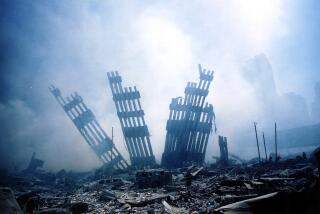‘A Fundamental Uncertainty’
WASHINGTON — These are excerpts from a prepared statement by the staff of the Sept. 11 commission summarizing their work so far.
Members of the commission, with your help, your staff has developed initial findings on the performance of the intelligence community against the danger of Islamic extremist terrorism before the Sept. 11 attacks on the United States. These findings may help frame some of the issues for this hearing and inform your work....
Today’s intelligence community is a collection of agencies which were largely created to help wage the Cold War. The Central Intelligence Agency was created in 1947. The Department of Defense was created in the same legislation. The signals intelligence agencies were in the armed services and were unified under the National Security Agency in 1952, yet stayed in the Defense Department.
The National Security Act forbids the CIA from performing any internal security functions. Internal security is the province of the FBI. In contrast, the CIA collects foreign intelligence focused on human sources outside of the United States. The CIA is also responsible for analyzing information from all sources to provide objective intelligence for the president and policymakers....
The United States spends more on intelligence than most nations spend on national security as a whole. Most of this money is spent on intelligence collection, much of it on very expensive hardware, such as systems based in space.
Most of the intelligence community’s budget is spent in the Department of Defense, in part because the collection systems are mainly managed by agencies set up in that department and in part because of the substantial intelligence organizations created to support the armed forces and the operations of the unified military commands around the world.
The director of central intelligence has two sets of responsibilities. First, he leads a particular agency, the CIA. The CIA has special responsibilities for clandestine intelligence collection and covert action and for independent analysis of foreign developments. Second ... he has the responsibility to coordinate the efforts of the entire intelligence community, this loose collection of federal agencies and parts of agencies, so that it purposefully and efficiently supports broad national priorities set by the president, the National Security Council and the Congress....
While we now know that Al Qaeda was formed in 1988 at the end of the Soviet occupation of Afghanistan, the intelligence community did not describe this organization, at least in documents we have seen, until 1999.
As late as 1997, the CTC characterized Osama bin Laden as a financier of terrorism. This was at a time when the intelligence community had recently received a major input of new information revealing that Bin Laden headed his own terrorist organization, with its own targeting agenda and operational commanders.
This new information also revealed the previously unknown involvement of Bin Laden’s organization in the 1992 attack on the Yemen hotel quartering U.S. military personnel and the 1993 shoot-down of U.S. Army Blackhawk helicopters in Somalia and, quite possibly, in the 1995 Riyadh bombing of the American training mission to the Saudi Arabian National Guard. Nor had any analysts worked through answers to questions about links between Bin Laden and his associates with the bombing of the World Trade Center in 1993....
Most important, our interviews of senior policymakers in both administrations revealed a fundamental uncertainty about how to regard the threat posed by Bin Laden and Al Qaeda. After 9/11, the catastrophic character of the threat seems obvious. It is hard now to recapture the old conventional wisdom before 9/11.
In other words, before the attack we found uncertainty among senior officials about whether this was just a new and especially venomous version of the ordinary terrorist threat America had lived with for decades, or was radically new, posing a threat beyond any yet experienced....
Human source intelligence is conducted by both the CIA and the Defense Intelligence Agency. Gaining access to organizations or individuals who have access to terrorist groups has proven extremely difficult for both the CIA and the DIA. This has led to a heavy reliance on “walk-ins” and foreign intelligence services.
Often, CIA’s best sources of information on terrorist organizations have been volunteers or walk-ins, who approach U.S. personnel at embassies and other places for a variety of reasons.
But evaluating these volunteers and walk-ins is a time-consuming and sometimes risky proposition. The ratio of valuable information providers to charlatans, fabricators or double agents is about 1 to 10. That is, for every 10 walk-ins, only one produces information of value to the intelligence community and U.S. policymakers. Yet some of the best sources on Al Qaeda during the 1990s were walk-ins.
On Dec. 4, 1998, [CIA Director George J.] Tenet issued a directive to several CIA officials and the DDCI for Community Management stating: “We are at war. I want no resources or people spared in this effort, either inside CIA or the community.”
Unfortunately, we found the memorandum had little overall effect on mobilizing the CIA or the intelligence community....
The DCI did not develop a management strategy for a war against terrorism before 9/11. Such a management strategy would define the capabilities the intelligence community must acquire for such a war, from language training to collection systems to analysts.
Such a management strategy would necessarily extend beyond the CTC to the components that feed its expertise and support its operations, linked transparently to counter-terrorism objectives. It would then detail the proposed expenditures and organizational changes required to acquire and implement these capabilities....
Conclusions:
Our investigation so far has found the intelligence community struggling to collect on and analyze the phenomena of transnational terrorism through the mid- to late 1990s.
While many dedicated officers worked day and night for years to piece together the growing body of evidence on Al Qaeda and to understand the threats, in the end it was not enough to gain the advantage before the 9/11 attacks.
* While there were many reports on Bin Laden and his growing Al Qaeda organization, there was no comprehensive estimate of the enemy, either to build consensus or clarify differences.
* With the important exception of attacks with chemical, biological, radiological or nuclear weapons, the methods developed for decades to warn of surprise attacks were not applied to the problem of warning against terrorist attacks.
* There was not a comprehensive review of what the community knew, what it did not know, followed by the development of a communitywide plan to close those gaps.
* The DCI ... was accountable for a community of loosely associated agencies and departmental offices that lacked the incentives to cooperate, collaborate and share information.
Like his predecessors, he focused his energies on where he could add the greatest value: the CIA, which is a fraction of the nation’s overall intelligence capability. As a result, a question remains: Who is in charge of intelligence?
More to Read
Sign up for Essential California
The most important California stories and recommendations in your inbox every morning.
You may occasionally receive promotional content from the Los Angeles Times.










